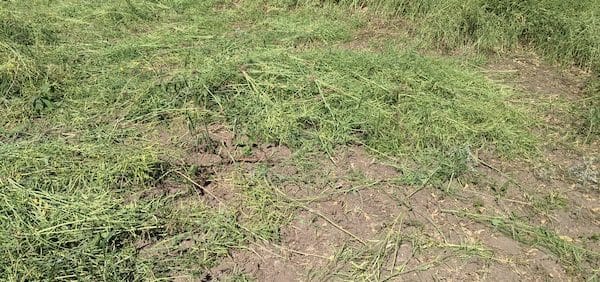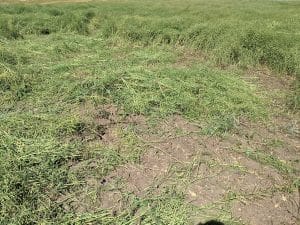You have been actively scouting and found clubroot early. The disease is confined to “patches” or small areas in your field, typically around field entrances, drainage paths or low spots in the field.
Here’s what to do with them:
- Scout and look for patches and patterns in the field. Confirm by pulling plants and looking for clubroot galls. You could also use DNA testing. (See below.)
- Mark out at an area at least two times the area of the clubroot patch. (For example, if the patch radius is 10m, mark out an area with a radius of 15m). Set visual and GPS markers for the area.
- If feasible, hand-pick all plants from the patch. (See below for a hand roguing experience.) Cut off the galls from all plants and put the galls in a heavy garbage bag. Take bags to the landfill. Another option is to burn the galls, but this has to be a complete burn. University of Alberta clubroot specialist Steve Strelkov says burning fresh moist galls might not kill all of the inoculum. Burning must be intense enough to turn all the wet material to ash. If burning, dispose of residue (which may still contain viable spores if the burn wasn’t hot enough) in a non-agricultural area where remnants can’t be moved around.
- Spraying or mowing the patch will not remove galls and resting spores.
- Add lime until soil pH reaches at least 7.2.
- Seed patches to sod-forming grass.
- Control host weeds and volunteer canola.
- Use soil sampling to monitor spore concentration. When clubroot spores are no longer detectable, or reduced to levels below your risk tolerance, break the sod.
Clubroot testing. Various labs will test soil for the presence of clubroot DNA and do a quantitative test, measuring the number of spores per gram of soil. Pathotype testing requires a more intense assay with the Canadian differential set. If you have galls you’d like to submit for pathotype testing, contact a CCC agronomy specialist. For pathotype testing, collect 20 to 40 galls (larger the gall the less you need). GPS the sample locations if possible. If not, take notes where the samples were taken. Record hybrid name, level of infestation (light, moderate, heavy) and location (entrance, low area, other), field Location – legal land location OR County/RM if grower requests confidentiality. Galls submitted for pathotype sampling should be frozen (but they have to stay frozen until arrival at the lab) or dried. To dry, put them in the sun or under a window (you don’t want them to blow away) and wait a couple of weeks, especially for big galls.
Hand roguing a patch. Brittany Hennig, who works for Alberta Canola, pulled out all the plants in this 20 by 20 foot (6 x 6 m) patch. (See photos below.) She cut off the galls and put them in a garbage bag for the landfill, and returned above-ground biomass to the field. Brittany says: “We spent just over four hours with two people. We picked until we couldn’t find any – but we are not confident we got it all, as we know how patchy clubroot is. My recommendation was to throw lime at it and seed it to grass for a visual to avoid the area for the following few years.”

